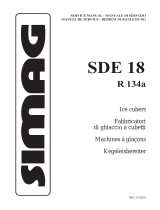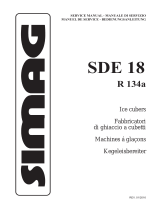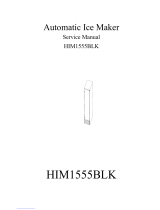4. Technical Specification - R22 Machines
MODEL FCI 20 FCI 30 FCI 40 FCI 60 FCI 85
Output – kg/24hr. 18 (20.5) 26 (34) 34 (42) 57 (70) 78 (90)
Bin storage capacity – kg 6.5 15 15 27 27
Cubes per cycle 16 24 24 48 48
kg per cycle 0.28 (0.38) 0.42 (0.6) 0.42 (0.6) 0.82 (1.2) 0.82 (1.2)
Cycle time – minutes 22 (25) 23.5 (24.5) 15.75 (19.15) 20.5 (23.6) 15.25 (18.75)
Amps start/run 9.5/1.9 (9.5/1.9) 11/2.2 (11/2.1) 16/3.3 (16/3.3) 16/3.5 (16/4) 24.5/4.4 (24.5/4)
Watts consumption 300 (280) 350 (330) 450 (450) 650 (650) 810 (760)
Water consumption 5.8lt/hr 5lt/hr 6.3lt/hr 12.5lt/hr 15.5lt/hr
Refrigerant R22 R22 R22 R22 R22
Ref. charge, grams 300gr 280gr 290gr 420gr 460gr
Heat rejection, watts 500 600 850 1100 1600
5. Operating Instructions - R22 Machines
5.1 Start Up
Affer having correctly installed the ice maker and completed the plumbing and electrical connections, perform the following ‘Start-up’
procedure.
A. Give power to the unit to start it up by switching ‘ON’ the power line main disconnect switch.
The 1st GREEN LED will glow.
NOTE: Every time the unit returns under power, after having been switched off, both the water inlet valve and the hot gas valve get energised
for a period of 5 minutes, thus to admit new water to the machine sump reservoir to fill it up and, eventually, to wash off any dirt that may be
deposited in it during the unit oft period (Fig. 1). Page 13
B. During the water filling operation, check to see that the incoming water dribbles, through the evaporator platen dribbler holes, down into the
sump reservoir to fill it up and also that the incoming surplus of water flows out through the overflow pipe into the drain line.
During the water filling phase the components energised are:
THE WATER INLET SOLENOID VALVE, THE HOT GAS SOLENOID VALVE, WATER DRAIN VALVE
NOTE: If in the 5 minutes length of the water filling phase the machine sump reservoir does not fill up to the rim of the overflow pipe, it is
advisable to check:
1. The water pressure of the water supply line that must be at least 1 bar (14 psig) Minimum (Max 5 bar-70 psig).
2. The filtering device installed in the water line that may reduce the water pressure below the Minimum value of 1 bar (14 psig).
3. Any clogging situation in the water circuit like the inlet water strainer and/or the flow control.
5.2 Operational Checks
C. At completion of the water filling phase (5 minutes) the unit passes automatically into the freezing cycle with the start up of: COMPRESSOR
WATER PUMP FAN MOTOR
in air cooled version (Fig. 2) Page 13 and the glowing of the 6th RED LED.
D. Check to see through the curtained ice discharge opening that the spray system is correctly seated and that the water jets uniformly reach the
interior of the inverted mould cups; also make sure that the plastic curtain is hanging freely and there is no excessive water spilling through it.
E. The ice making process takes place thereby, with the water sprayed into the moulds getting gradually refrigerated by the heat exchange occurring
with the refrigerant flowing into the evaporator serpentine.
During the freezing process, when the evaporator temperature falls to 0˚C (35˚F) the evaporator temperature sensor, located in contact with
the evaporator serpentine, supplies a low voltage power signal to the electronic control device (P.C. BOARD) which in first instance generates
the glowing of the 5th RED LED located in the front of the printed circuit board (Fig. 3). Page 13
F. The unit remains however in its normal freezing cycle mode until the evaporator temperature detected by the sensor reaches the temperature
of -13˚C (8.5˚F) on models 20, 30 40 and 60 and to -16˚C (3˚F) on model 85.
When the evaporator temperature falls below the above value, the evaporator temperature sensor supplies a low voltage power signal to the
P.C. BOARD in order to activate the electronic timer. This takes over the control of the freezing cycle up to the complete formation of the ice
cubes (Fig. 4) Page 13, with the lighting up of the 4th RED LED located just above the previous lighted one.
NOTE The length of the entire freezing cycle is the sum of the lengths of three phases, two of which, (T1 + T2) controlled by the evaporator
tempemtum sensor, which has its probe placed in contact with the evaporator serpentine (non adjustable), and ONE. (Ta) by the electronic
tImer (Adjustable) incorporated in the P.C. BOARD.
The lengths of the first two phases, related to the evaporator temperature and controlled by its sensor, are:
TI - The time elapsed since the beginning of freezing cycle up to when the evaporator reaches the temperature of 0˚C (35˚F).
T2 - The time required for the evaporator to fall from 0˚C (35˚F) to -13˚C (8.5˚F) or to 16˚C (3˚F).
The third time Ta - Time added - is in relation to one of the different combinations of the five keys
3,4,5, 6, and 7 of the DIP SWITCH located
in the front of the P.C. BOARD. The combination is factory set in consideration of the ice maker type and of its cooling version. It is possible,
however, to vary the timed length of the freezing cycle, by changing the DIP SWITCH keys settings.
In Table B are shown the various time extensions of the freezing cycle third phase Ta, in relation with the different DIP SWITCH keys
settings.
G. After about 20-22 minutes from the beginning of the freezing cycle, in a hypothetic ambient temperature of 21˚C (70˚F), the defrost cycle takes
place with the hot gas and the water inlet valves being simultaneously activated (Fig. 5). Page 13
The electrical components in operation in this new situation are:
8
ambient temperature as detailed in Table C. Page 18.
The electrical components in operation during this phase are:
COMPRESSOR
WATER PUMP
WATER INLET SOLENOID VALVE
HOT GAS SOLENOID VALVE
The incoming water, passing through the water inlet valve and the flow control, runs over the evaporator platen and then flows by gravity through
the dribbler holes down into the sump/reservoir.
The water filling the sump/reservior forces part of the surplus water from the previous freezing cycle to go out to the waste through the overflow
pipe. This overflow limits the level of the sump water which will be used to produce the next batch of ice cubes.
Meanwhile, the high pressure, high temperature refrigerant, discharged from the compressor, flows through the hot gas valve directly into the
evaporator serpentine by-passing the condenser.
The hot gas circulating into the serpentine of the evaporator warms up the copper moulds causing the defrosting of the ice cubes. The ice
cubes, released from the cups, drop by gravity onto a slanted cube chute, then through a curtained opening they fall into the storage bin.
NOTE: The length of the defrost cycle, factory set, can vary in accordance with the actual ambient temperature (as shown on Table C). Page
18. For instance, in a high ambient temperature situation it can be reduced to recover some of the time spent for the longer freezing cycle.
At the end of the defrost cycle, both the hot gas and the water inlet valves close, so the machine initiates another freezing cycle.
11.4 Operation - Control Sequence
At the start of the freezing cycle, the evaporator temperature sensor controls the length of the first part of the freezing cycle. As it reaches a
pre-determined temperature, it supplies a low voltage current to the P.C. BOARD in order to activate the electronic timer which takes over the
control of the freezing cycle for a pre-fixed time according to the DIP SWITCH keys setting (see Table B). Page 18.
NOTE: The evaporator temperature sensor, factory pre-set, is the same for all the models and is not adjustable in the field.
Once completed the freezing cycle 2nd phase the system goes automatically into the defrost cycle which has also a pre-fixed length that can
vary depending upon the actual ambient temperature as shown in Table C. Page 18.
At completion of the defrost cycle the P.C. BOARD command the unit to start again a new freezing cycle.
12. Components Description
12.1 Evaporator Temperature Sensor
The evaporator temperature sensor probe, located in contact with the evaporator serpentine detects the dropping of the evaporator temperature
during the freezing cycle and signals it by supplying a current flow to the micro processor of the P.C. BOARD.
According to the current received, the evaporator sensor supplies power to the P.C. BOARD first, when it reaches 0°C (32°F), second at -15°C
(5°F); in this second case its supply power to the electronic timer built into the P.C. BOARD so that it may take control of the length of the 2nd
phase of freezing cycle.
The length of the timed phase is pre-fixed by the setting of the keys 1, 2, 3 and 4 of the DIP SWITCH.
The activation of the electronic timer (-15°C -5°F) is monitored by the lighting up of the RED LED placed in the front of the P.C. BOARD. This
lighting up occurs usually in the mid period of the freezing cycle and signals the switching from the first to the second phase of the freezing
cycle.
12.2 Condenser Temperature Sensor
The condenser temperature sensor probe, located within the condenser fins (air cooled version) or in contact with the tube coil (water cooled
version) detects the condenser temperature variations and signals them by supplying current, at low voltage, to the P.C. BOARD.
In the air cooled versions, in relation to the different current received, the micro processor of the the P.C. BOARD supplies, through a TRIAC,
the power at high voltage to the fan motor so to cool the condenser and to reduce its temperature rises and reaches 75°C (170°F) the current
arriving to the micro processor is such to cause an immediate and total stop of the machine operation.
12.3 Ambient Temperature Sensor
The probe of this sensor, located in the front of the ice maker condenser (air cooled version) and in the water supply line to the condenser
(water cooled version) has the function to detect the ambient or the water temperature and, by changing its own electrical resistance, supplies
a different current flow to the P.C. BOARD.
This different current flow received by the P.C. BOARD, is processed by the micro processor in order to extend or shorten the defrost cycle
length (longer in cold ambient situations, shorter in warm ones).
12.4 Ice Bin Level Light Control
The electronic ice bin level control, located into the storage bin, has the function to stop the operation of the ice machine when the light beam
between the light source and the sensor is interrupted by the ice cubes stored in the bin. When the light beam is interrupted the RED LED
located in the front of the P.C. BOARD goes off; in case the light beam is constantly interrupted for more than 60 seconds, the ice machine
stops with the glowing-up of the 2nd YELLOW LED to monitor the situation of ice bin full. The 60 seconds of delay prevent that an ice scoop
movement or the ice dropping through the ice chute (interrupting for a while the light beam) can stop the operation of the unit.
As soon as the ice is scooped out (with the resumption of the light beam between the two infrared sensor of ice level control) the RED LED is
lighted up and after 6 seconds the ice machine restarts again with the extinguishing of the 2nd YELLOW LED.
12.5 E.P.C. Board (Data processor)
The P.C. BOARD, fitted in its plastic box located in the front of the unit, consists of two separated printed circuits one at high and the other
at low voltage integrated with a program selector, of two fuses one on power in (100m A) and one on power out (16 A) of five aligned
LEDS
monitoring the operation of the machine, of two extra monitoring RED LEDS, of one DIP SWITCH with ten keys, of two small plugs located on
its back side, of input terminals for the leads of the sensor probes and input and output terminals for the leads of the ice maker electrical wires.
The P.C. BOARD is the brain of the system and it processes, through its micro processor, the signals received from the four sensors in order
to control the operation of the different electrical components of the ice maker (compressor, water, pump, solenoid valves, etc.).
By turning the program selector it is possible to put the unit in the following different situations.
CLEANING/RINSING: The water pump is the only electrical component in operation and it must be used during the cleaning or the rinsing
procedure of the water system of ice machine.
STAND BY: The unit remain under electrical power but OUT of operation. It can be used by the service engineer in order to stop the unit during
17
























